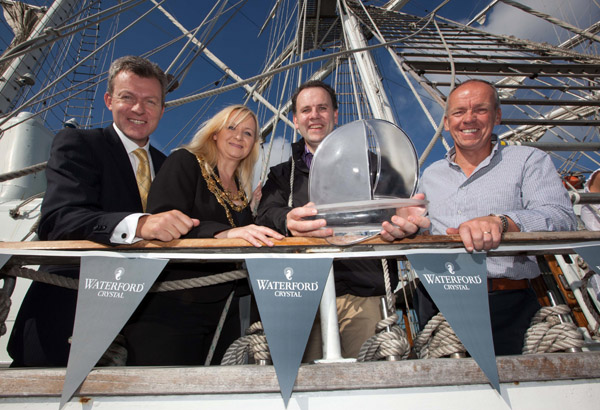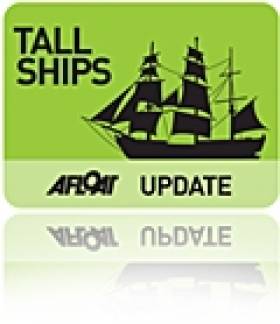Displaying items by tag: Lord Nelson
Tall Ship ‘Lord Nelson’ Put Up for Sale by Online Action
Lord Nelson, the former flagship tall ship of the Jubilee Sailing Trust, has been put up for sale by online auction.
Global advisory and investment firm Gordon Brothers was last October appointed as exclusive selling agent for the tall ship on behalf of the Jubilee Sailing Trust Limited after the troubled charity was placed into administration.
It’s now offering the vessel for sale by online auction with bids opening at £150,000 and accepted until Friday 30 June.
Built in 1985, Lord Nelson is the first tall ship in the world designed to accommodate personnel of all physical abilities to sail alongside the ship’s crew.
The 55-metre, 368-tonne sail training barque — which was decommissioned in 2019 — includes accessible toilets, a speaking compass, braille and power-assisted bridge.
Announcing the auction on Wednesday (7 June), Simon Bamford, director of commercial and industrial at Gordon Brothers said: “Lord Nelson is back on the market and presents a fantastic and rare opportunity to acquire a vessel through an online auction within the international marine markets.
“This historic and renowned training ship accommodates any individual who sails and has circumnavigated the globe and sailed at various races and regattas.”
Tallship For All Follows In Wake of MOD70 City Races
#TALL SHIP- The UK flagged tallship Lord Nelson, built specifically to enable people of all physical abilities to sail side-by-side as equals, last night anchored off Scotsman Bay. It was in these inshore waters recently where the impressive MOD70 'City' Races took place off Dun Laoghaire Harbour's East Pier, writes Jehan Ashmore.
The barque is run by the charity, Jubilee Sailing Trust (JST), and she followed in the wake of another albeit smaller tallship, Vilma, which too had anchored in Scotsmans Bay, though much closer to the shoreline. The Welsh schooner registered in Beaumaris, was in the flotilla with spectators to witness the MOD70s as the high-tech 'Formula 1' of boats belted across Dublin Bay.
JST also own another barque, the Tenacious, and both vessels are regular callers to Irish ports, where they provide sailing holidays for everyone to experience the thrill and adventure of life at sea and get involved in almost every activity on board. This can involve taking the helm, setting the sails and keeping watch, regardless of physical ability and previous sailing knowledge.
For details of voyages around the UK and Ireland click HERE, noting the vessels also cruise in far distant waters. For example Lord Nelson is scheduled to depart on a voyage from Kochi in India next year.
Dunmore East Bids TallShips Farewell
As the Russian 'A' class Mir passed the LE Aoife off Dunmore East in mid-morning, the largest tall ship of the festival headed the start of the Parade of Sail, writes Jehan Ashmore.
Crowds left their cars in fields outside Dunmore East and descended into the harbour and surrounding headlands to witness the highlight of the four-day festival. Adding to the scene were the numerous leisure-craft, yachts and intrepid kayakers that gathered to greet the procession which took some two hours to pass the fishing harbour.
No sooner had the fully-rigged ship Mir had slipped beyond the anchored naval vessel that the gaff schooner Johanna Lucretia, under full sail came closer into view. She was closely followed by the Ocean Youth Trust Scotland's Bermudan cutter Alba Explorer.

The Russian 'A' class Mir passing the LE Aoife off Dunmore East. Photo: Jehan Ashmore
Of all the 45 tallships participating the Columbian Navy's barque ARC Gloria presented the most colourful entrant. She proudly flew a large horizontal tricolor of yellow, blue and red representing the South American nation.
When it came to the turn of the Europa to pass the LE Aoife, the tug Bargarth gave a wonderful send-off with the traditional display of water jets shooting sky-high, nearly reaching the top of the three-masted barque.
Marking the tail-end of the parade was the Jubilee Sailing Trust's Lord Nelson, another barque that departed the estuary with the Hook Head Lighthouse forming a majestic backdrop.
At this stage several of the large tallships could be seen on the far horizon in preperation to the start of the first race leg of this years Tall Ships Races....next port of call Greenock!
- Waterford
- ship
- Dunmore East
- Lord Nelson
- Waterford Estuary
- LE Aoife
- Sail Training International
- Jubilee Sailing Trust
- Tug
- Hook Head
- Tall
- JOHANNA LUCRETIA
- TallShips
- Waterford Harbour
- JST
- Europa
- Fullyrigged ship
- STI
- ARC Gloria
- Hook Head Lighthouse
- Mir
- Gaff schooner
- Ocean Youth Trust Scotland
- Bermudan cutter
- Alba Explorer
- Columbian Navy barque
- Bargarth
- Fastnet Shipping
Lord Nelson Heads for Waterford
As the Tall Ship STS Lord Nelson nears Carnsore Point off Wexford this evening the barque will be one of the many vessels participating in the Waterford Talls Ships Races Festival, writes Jehan Ashmore.
Joining Lord Nelson are three other UK entrants, they are the Jean de la Lune, Pelican of London and Royalist now celebrating her 40th anniversary. Together these tallships belong to the 'A' class vessels, the largest of the tallships. The impressive array of A class vessels includes four ships alone from The Netherlands with the Astrid, Eendracht, Europa and Wylde Swan, a schooner built in 1920.
From Norway is the fully rigged tallship Christian Radich and Sorlandet. The Poles are coming with their Pogoria. Neighbouring Russia are sending their impressive 108m long Mir which has 26 sails and has a 200-strong crew though the 1987 built vessel can be sailed with just 30. The final A class entrant is from outside Europe, the Columbian 1,300 tonnes Gloria, a three-master of over 60 metres long.
In addition to this exciting line-up are the 'B' and 'C' class which in total brings 45 tallships of all shapes and sizes to the quays of the River Suir. The crystal city will be host to over 1,000 trainess and over 400 professional crew who will take part in the colourful 'Crew Parade' held on Friday. For a full list of tallships and accompanying photos go to www.waterfordtallshipsrace.ie/the-race/the-tall-ships/
The spectacle of the festival will culminate in the early hours of Sunday when the fleet departs the city and heads downriver with a 'Parade of Sail' in the estuary of Waterford Harbour. As the tallships pass offshore of Dunmore East, this will mark the start of the first race-leg to Greenock.
The famous race is organised by Sail Training International (STI) a charity established to harness sail training to develop and educate young people, regardless of nationality, culture, religion, gender or social background.
The STI can trace its roots with the creation of the Sail Training International Race Committee which organised the first race of sail training tall ships in 1956. Their website is www.sailtraininginternational.org/
‘Bounty’ Joins Belfast’s Titanic Maritime Festival
The US-flagged replica tallship H.M.S. Bounty arrived into Belfast Lough this morning for the Belfast Titanic Maritime Festival (24-26 June), writes Jehan Ashmore.
Measuring some 200 tonnes, the three masted-replica ship of the original H.M.A.V Bounty where the famous mutiny against Captain William Bligh took place in Tahiti in 1789, is to open to the public.
The replica was constructed in Nova Scotia of the original Hull-built vessel for the 1962 MGM film 'Mutiny on the Bounty' starring Hollywood screen legend Marlon Brando.
The Bounty was also used in the filming of Pirates of the Caribbean II and a Lone Wolf Production Group documentary on Blackbeard and has featured in several documentaries.
'Bounty' will be open to visitors (for information www.tallshipbounty.org) and is to be accompanied by the Jubilee Sailing Trust's Lord Nelson (www.jst.org.uk/).
The festival venue is at the Queen's Quay, Abercorn Basin and Arc, behind the Premier Inn Hotel at the Titanic Quarter.
As for the Titanic, tours of the old main offices of the H&W shipyard on the Queen's Road courtesy of the Titanic Quarter Ltd will be open to the public with displays relating to Titanic and Edwardian Fashion.
In addition Titanic Bus Tours lasting two hours which are free are available from the Belfast Welcome Centre, to contact Tel: 028 9024 6609.
For a complete listing of the festival events, dates and opening hours go to www.belfastcity.gov.uk/maritimefestival/index.asp
- Belfast
- Port of Belfast
- Lord Nelson
- Belfast Lough
- Titanic
- Jubilee Sailing Trust
- Titanic Quarter
- Belfast Harbour Commissioners
- Tahiti
- Harland & Wolff
- Belfast Lough News
- MGM
- Hollywood
- Maritime Festivals
- Mutiny on the Bounty
- Captain William Bligh
- Marlon Brando
- H.M.S. Bounty
- H.M.A.V. Bounty
- The Bounty
- MGM Film Studies
- Replica tallship
- Maritime Events
- SS Titanic
- H&W
- JST
- Holiday Inn
- Queen's Quay
- Abercorn Basin
- Titanic Quarter Ltd
- Belfast Welcome Centre
Places on Offer on Tall Ship Lord Nelson
The Lord Nelson Tall Ship is still looking for enthusiastic participants to join the EU Exchange programme from 30 July to 12 august this summer. The Lord Nelson is a special vessel. It is designed in a way that people with different disabilities can join an adventure on a Tall Ship.
So who can join? Everybody, as no prior sailing experience needed! And whether you are in a wheelchair or you're blind, on the Lord Nelson this is no issue. The experienced crew will teach you everything you need to know in order to sail a Tall Ship.
More details on the Afloat forum post here
Setting Sails for Waterford's Tall Ships Race
The four-day maritime spectacle expects to attract 500,000 visitors to throng the quays of the 'Crystal' city. Presented by Szczecin and organised by Sail Training International, the prestigious event is supported through host-port partners, 3, Bulmers Original Irish Cider and Waterford Crystal. In addition the host-port educational partner is Waterford Institute of Technology and the official media partner covering the event is RTE. Between them over €450,000 has been raised to support funding.
Waterford City Council and the Port of Waterford are providing leading roles as delivering agencies having jointly mounted the bid to secure staging the Tall Ships Races return following the city's successful hosting of the event in 2005.
Notably in that year's 'Parade of Sail' the procession was led by Asgard II, followed astern by Jeanie Johnston and Dunbrody. The involvement of all Irish tall-ships was an historical occasion particularly in view of the sinking of Asgard II three years later.
In 2005, Waterford also claimed to be the first Irish host port to be the starting port for the race and this will be repeated in 2011.

Gary Breen, Failte Ireland; Cllr Mary Roche,Mayor of Waterford,David McCoy, House of Waterford Crystal and Des Whelan, Chairman, The Tall Ships Races 2011 onboard the 'Lord Nelson' in Waterford. Photo: Dylan Vaughan
At the reception onboard Lord Nelson, Cllr Mary Roche, Mayor of Waterford said: "To 3,Bulmers,RTE, Waterford Crystal and Waterford Institute of Technology, I say a very sincere thank you on behalf of the people of Waterford and all of those around Europe and beyond who will be here next summer for what promises to be four magical days of free fun in Ireland's oldest city".
Next year's hosting is also to be supported by Failte Ireland which is allocating resources of €3m while Tourism Ireland will embark on an intensive marketing campaign during the mid summer event, which is billed to be the biggest event in Ireland.
There will be between 80-100 tall-ships and their international crews converging in Waterford. Among the vessels confirmed is the 1937-built, Christian Radich which starred in the 1958 film, The Windjammer and also featured in the 1970's television series, The Onedin Line.
Incidentally the Christian Radich was used, albeit with limited trainee spaces allocated to Coist an Asgard in an arrangement with the vessel's Norwegian owners in 2009, the first full year of the national sail training programme since the sinking of Asgard II the previous year.
The staging costs of the 2011 Tall Ships is estimated at €3.5m and is expected to generate €35m to Waterford City and hinterland. The organisers of the event will be embracing social technology communications networks with presentations on Facebook, Twitter and other servers.
Last year Belfast held the honour in welcoming the finale of the Tall Ship Races, incorporating the Tall Ships Atlantic Challenge. Dublin hosted the event in 1998, albeit the race was then known as the Cutty Sark Tall Ships Race with this same title applying to the race when the event visited Cork Harbour in 1991.
Looking for further reading on Tall Ships in Ireland? Click the links below:
Click this link to read all our Tall Ships Stories on one handy page
Previewing Ireland's Tall Ships 2011 Season
Can Ireland Get a New Tall Ship?
Lord Nelson Pays Dun Laoghaire a Visit
The Lord Nelson struck a lovely sailing pose crossing Dublin Bay this week. The disabled sail training vessel berthed overnight in Dun Laoghaire Harbour and Gareth Craig photographed her leaving. Images on the gallery now.
Looking for further reading on Tall Ships in Ireland? Click the links below:
Click this link to read all our Tall Ships Stories on one handy page
Previewing Ireland's Tall Ships 2011 Season
Can Ireland Get a New Tall Ship?


































































